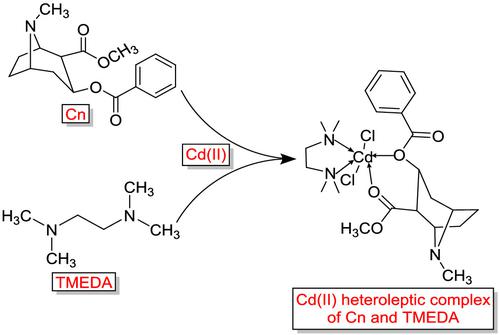当前位置:
X-MOL 学术
›
Appl. Organomet. Chem.
›
论文详情
Our official English website, www.x-mol.net, welcomes your
feedback! (Note: you will need to create a separate account there.)
Synthesis, structural characterization, density functional theory calculations, and antimicrobial, anticancer, and antimetastatic properties of nanosized heteroleptic complexes of cocaine/TMEDA with d-block metal ions
Applied Organometallic Chemistry ( IF 3.7 ) Pub Date : 2021-09-07 , DOI: 10.1002/aoc.6441 Abanoub Mosaad Abdallah 1 , Nadia G. Zaki 1 , Walaa H. Mahmoud 2 , Ahmed M. El Kerdawy 3, 4 , Gehad G. Mohamed 2
Applied Organometallic Chemistry ( IF 3.7 ) Pub Date : 2021-09-07 , DOI: 10.1002/aoc.6441 Abanoub Mosaad Abdallah 1 , Nadia G. Zaki 1 , Walaa H. Mahmoud 2 , Ahmed M. El Kerdawy 3, 4 , Gehad G. Mohamed 2
Affiliation

|
In the field of transition metal chemistry, the development of transition metal-based drugs for the treatment of diseases such as cancer or microbial infections with minimization of adverse effects and drug resistance constitutes an active area of research. Herein, eight novel nanosized heteroleptic complexes of cocaine/TMEDA with the formula [M(COC)(TMEDA)Cly(OH2)z]nCl·xH2O (M = Cr(III), Mn(II), Fe(III), Co(II), Ni(II), Cu(II), Zn(II), and Cd(II); COC = cocaine; TMEDA = N,N,N′,N′-tetramethylethylenediamine, y = 1–2; z = 0–1; n = 0–1; and x = 0–2) were synthesized and structurally characterized via elemental analysis, molar conductivity, mass spectrometry, and spectroscopic and microscopic techniques. The thermal properties and kinetic thermodynamic parameters of the synthesized complexes were also studied. The geometry and electronic structures were investigated via density functional theory (DFT) calculations. The antiproliferative activity of the complexes on HepG-2 and MCF-7 cancer cell lines was quantified via MTT assay. The Fe(III) and Cd(II) complexes exhibited promising cytotoxic activities against the HepG-2 and MCF-7 cancer cell lines, respectively, with minimum effect on HFB4 human normal cells. Further molecular mechanistic studies were performed on the Cd(II) complex to inspect its influence on different cancer pathophysiology-related processes in the MCF-7 cell line including metastasis, apoptosis, and cellular oxidative stress and on the cellular levels of the human tumor suppressor nuclear proteins p21 and p27. The results revealed that the Cd(II) complex is a promising anticancer agent that acts through several molecular mechanisms with minimum effect on the normal cells and with additional antimetastatic properties. Furthermore, the antibacterial and antifungal activities of the prepared complexes were investigated.
中文翻译:

可卡因/TMEDA 与 d 区金属离子纳米尺寸杂配复合物的合成、结构表征、密度泛函理论计算以及抗菌、抗癌和抗转移特性
在过渡金属化学领域,开发用于治疗癌症或微生物感染等疾病的过渡金属药物,将不良反应和耐药性降至最低,是一个活跃的研究领域。在此,八种新型可卡因/TMEDA 纳米级杂配配合物具有式 [M(COC)(TMEDA)Cl y (OH 2 ) z ]nCl· x H 2 O (M = Cr(III), Mn(II), Fe (III)、Co(II)、Ni(II)、Cu(II)、Zn(II)和Cd(II);COC = 可卡因;TMEDA = N、N、N '、N'-四甲基乙二胺,y = 1–2;z = 0–1;n = 0–1; 和x = 0-2) 通过元素分析、摩尔电导率、质谱、光谱和显微技术合成和结构表征。还研究了合成配合物的热性质和动力学热力学参数。通过密度泛函理论(DFT)计算研究了几何和电子结构。通过 MTT 测定量化复合物对 HepG-2 和 MCF-7 癌细胞系的抗增殖活性。Fe(III) 和 Cd(II) 复合物分别对 HepG-2 和 MCF-7 癌细胞系表现出有希望的细胞毒活性,对 HFB4 人类正常细胞的影响最小。对 Cd(II) 复合物进行了进一步的分子机制研究,以检查其对 MCF-7 细胞系中不同癌症病理生理学相关过程的影响,包括转移、凋亡和细胞氧化应激以及人类肿瘤抑制因子的细胞水平核蛋白 p21 和 p27。结果表明,Cd(II) 复合物是一种很有前景的抗癌剂,它通过多种分子机制发挥作用,对正常细胞的影响最小,并具有额外的抗转移特性。此外,研究了制备的复合物的抗菌和抗真菌活性。结果表明,Cd(II) 复合物是一种很有前景的抗癌剂,它通过多种分子机制发挥作用,对正常细胞的影响最小,并具有额外的抗转移特性。此外,研究了制备的复合物的抗菌和抗真菌活性。结果表明,Cd(II) 复合物是一种很有前景的抗癌剂,它通过多种分子机制发挥作用,对正常细胞的影响最小,并具有额外的抗转移特性。此外,研究了制备的复合物的抗菌和抗真菌活性。
更新日期:2021-09-07
中文翻译:

可卡因/TMEDA 与 d 区金属离子纳米尺寸杂配复合物的合成、结构表征、密度泛函理论计算以及抗菌、抗癌和抗转移特性
在过渡金属化学领域,开发用于治疗癌症或微生物感染等疾病的过渡金属药物,将不良反应和耐药性降至最低,是一个活跃的研究领域。在此,八种新型可卡因/TMEDA 纳米级杂配配合物具有式 [M(COC)(TMEDA)Cl y (OH 2 ) z ]nCl· x H 2 O (M = Cr(III), Mn(II), Fe (III)、Co(II)、Ni(II)、Cu(II)、Zn(II)和Cd(II);COC = 可卡因;TMEDA = N、N、N '、N'-四甲基乙二胺,y = 1–2;z = 0–1;n = 0–1; 和x = 0-2) 通过元素分析、摩尔电导率、质谱、光谱和显微技术合成和结构表征。还研究了合成配合物的热性质和动力学热力学参数。通过密度泛函理论(DFT)计算研究了几何和电子结构。通过 MTT 测定量化复合物对 HepG-2 和 MCF-7 癌细胞系的抗增殖活性。Fe(III) 和 Cd(II) 复合物分别对 HepG-2 和 MCF-7 癌细胞系表现出有希望的细胞毒活性,对 HFB4 人类正常细胞的影响最小。对 Cd(II) 复合物进行了进一步的分子机制研究,以检查其对 MCF-7 细胞系中不同癌症病理生理学相关过程的影响,包括转移、凋亡和细胞氧化应激以及人类肿瘤抑制因子的细胞水平核蛋白 p21 和 p27。结果表明,Cd(II) 复合物是一种很有前景的抗癌剂,它通过多种分子机制发挥作用,对正常细胞的影响最小,并具有额外的抗转移特性。此外,研究了制备的复合物的抗菌和抗真菌活性。结果表明,Cd(II) 复合物是一种很有前景的抗癌剂,它通过多种分子机制发挥作用,对正常细胞的影响最小,并具有额外的抗转移特性。此外,研究了制备的复合物的抗菌和抗真菌活性。结果表明,Cd(II) 复合物是一种很有前景的抗癌剂,它通过多种分子机制发挥作用,对正常细胞的影响最小,并具有额外的抗转移特性。此外,研究了制备的复合物的抗菌和抗真菌活性。











































 京公网安备 11010802027423号
京公网安备 11010802027423号